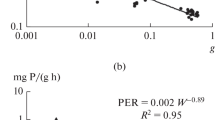Summary
Between 1976–1978, we studied the ecology of the Sphincterochila prophetarum, the most common snail, on stony slopes in Northern Negev. Energy and water flow determinations were made at the individual and population levels on a field observation basis and metabolic data were derived from laboratory simulations.
The snails are active during 5–7% of the time during the year, while the remaining 95% of the time, the snails are in aestivation under stones. The energy and water inputs during the short feeding periods are very fast. Only 8% of the total energy in the eaten food are assimilated. Eighty-nine percent of the total assimilated energy are utilized in respiration during the various periods of activity and dormancy.
The water loss during the feeding and activity period is about 37% of the total annual input. The snails lose twice as much the amount of water during the winter dormancy periods than in the summer dormancy period.
Similar content being viewed by others
References
Bar Z (1975) Distribution and habitat of the genus Sphincterochila in Israel and Sinai. Argamon, Israel J Malac 5:1–19
Evenari M, Shanan L, Tadmor N (1971) The Negev. 345 pp Cambridge Mass, Harvard University Press
Graham J (1973) Breeding energetics of littorea (L) (Gastropoda: Prosobranchiata). J Anim Ecol 42:391–403
Griffiths D (1977) Caloric variation in Crustacca and other animals. J Anim Ecol 45:593–605
Grimm R (1973) Zum Energieumsatz phytophager Insekten im Buchenwald. I Untersuchungen an Populationen der Rüsselkäfer (Curculionidae) Rhynchaenus fagi L, Strophosomus (Schonherr) und Otiorrhynchus singularis L. Oecologia (Berl) 11:187–262
Lund JWG (1962) Soil Algae in Physiology and Biochemistry of Algae. In: Lewin R (ed) New York, Academic Press, pp 759–770
Mayland HF, McIntosh JH, Fuller WH (1966) Fixation of isotopic nitrogen on a semi-arid soil by algal crust organisms. Soil Sc Soc Amer Proc 30:50–60
Noy-Meir E (1973) Desert ecosystems: environment and producers. Ann Rev Ecol Systematics 4:25
Noy-Meir E (1974) Desert ecosystems: higher trophic levels. Ann Rev Ecol Systematics 5:195–214
Petrusewicz L, Macfadyen A (1970) A Productivity of terrestrial animals: Principles and Methods. IBP Handbook, No 13
Schachak M, Orr Y, Steinberger Y (1975) Field observation on the natural history of Sphincterochila (S) Zonata (Bourguignat, 1853) (=S Boissieri Charpentier, 1846). Argamon, Israel. J Malac 6:20–46
Schachak M, Chapman EA, Orr Y (1976) Some aspects of the ecology of the desert snail Sphincterochila Boissieri in relation to water and energy flow. Israel J of Med Sci 12:887–891
Schachak M, Steinberger S (1980) An Algae-desert snail food chain: Energy flow and soil turnover. Oecologia (Berl) 46:402–422
Shafee MS (1978) Variation in biochemical composition of the green mussel Perna Viridis Linnaeus of Ennore Estuary, Mardas Mahasagar-Bulletin of the National Institute of Oceanography II. pp 101–104
Shields LM, Durrell LM (1964) Algae in relation to soil fertility. Bot Rev 30:93–128
Shkolnik A (1966) Studies in the comparative biology of Israel's two species of Spiny Mice (Genus Acomys). Ph D Thesis submitted to the senate of the Hebrew University.
Steinberger Y (1979) Some aspects of the ecology of the desert snail Sphincterochila prophetarum. Ph D Thesis submitted to the senate of Bar-Ilan University. pp 135
Strong KW, Daborn GR (1978) Seasonal variation in ash and caloric content of Idotea baltica (pallas) (Crustacea:Isopoda). Canadian J of Zool 56:1917–1921
Wissing TE, Hasler AD (1971) Interseasonal change in caloric content of some fresh water invertebrates. Ecology 52:371–373
Tom-Tov Y (1970) Investigations in the ecology and survival of two snails in the Negev desert. Ph D Thesis submitted to the Senate of Tel-Aviv Univ. pp 127
Yom-Tov Y (1971) The biology of two desert snails Trochoidea (Xerocrassa) seetzeni and Sphincterochila boissieri. Israel J of Zool 20:231–248
Author information
Authors and Affiliations
Additional information
Dedicated to Prof. Evenari and Dr. Springer
Rights and permissions
About this article
Cite this article
Steinberger, Y., Grossman, S. & Dubinsky, Z. Some aspects of the ecology of the desert snail Sphincterochila prophetarum in relation to energy and water flow. Oecologia 50, 103–108 (1981). https://doi.org/10.1007/BF00378801
Received:
Issue Date:
DOI: https://doi.org/10.1007/BF00378801



